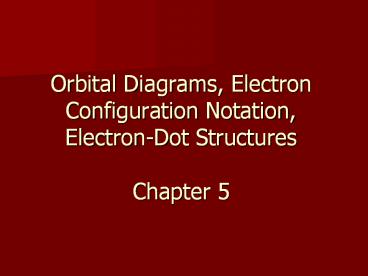Orbital Diagrams, Electron Configuration Notation, Electron-Dot Structures Chapter 5 - PowerPoint PPT Presentation
Title:
Orbital Diagrams, Electron Configuration Notation, Electron-Dot Structures Chapter 5
Description:
Title: Lab Safety, Scientific Method, Accuracy v. Precision, & Significant Digits Author: Karen LaFollette Shumway Last modified by: Karen L. Shumway – PowerPoint PPT presentation
Number of Views:129
Avg rating:3.0/5.0
Title: Orbital Diagrams, Electron Configuration Notation, Electron-Dot Structures Chapter 5
1
Orbital Diagrams, Electron Configuration
Notation, Electron-Dot Structures Chapter 5
2
Lecture Objectives
- Give the electron configuration for elements when
given the Atomic number (in both spectroscopic
notation and pictorially). - List for any element the last energy level
occupied by electrons and the number of electrons
occupying the energy level. - Draw a dot diagram of an element to represent the
valence electrons.
3
Aufbau Diagrams
- Uses individual orbitals
- Gives subshell arrangement
- Each orbital takes one electron before any other
orbital in the same subshell can receive a second
electron - Also called an orbital diagram
- e.g. Orbital Diagram for A Nitrogen Atom
N 1s 2s 2p 3s
4
Orbital Diagram for A Magnesium Atom
- Mg
- 1s 2s 2p 3s
??
??
??
??
??
??
5
Practice Diagram
- Write the orbital diagram for the electrons in
an oxygen atom.
6
Diagram Solution
- Write the orbital diagram for the electrons in
an oxygen atom. - 1s 2s 2p 3s
??
??
?
??
?
7
Practice Diagram
- Write the orbital diagram for the electrons in
an iron atom.
8
Diagram Solution
- Write the orbital diagram for the electrons in
an iron atom. - 1s 2s 2p 3s 3p
- 3d
??
??
??
??
??
??
??
??
??
?
?
?
?
??
9
Electron Configuration
- Spectroscopic notation specifies the shorthand
for the electrons in an element. - Quantum number n is the coefficient for each l
value, and the number of electrons in each
orbital is indicated by superscript values. - e.g. The electron configuration for nitrogen is
1s22s22p3 - e.g. The electron configuration for magnesium is
1s22s22p63s2
10
Practice in Electron Configuration
- What is the Electron Configuration for oxygen?
- 1s22s22p4
- Draw oxygens electron configuration as an
orbital diagram. - What is the Electron Configuration for iron?
- 1s22s22p63s23p64s23d6
- Draw irons electron configuration as an orbital
diagram.
11
Valence Electrons
- The valence electrons are the electrons in the
outermost orbitals of an atom. - It is only the valence electrons that determine
the chemical properties of an element. - The number of valence electrons can easily be
determined for Groups 1, 2, and 13-18. - These groups are also called 1A, 2A, and 3A-8A,
which just happen to represent the total number
of valence electrons for the elements in each of
these columns.
12
Valence Electrons
- The number of valence electrons is less obvious
for Group 3-12 elements. - Look at the electron configuration and determine
how many electrons are in the last level. This
works for all elements through vanadium (atomic
number 23). - Beyond this, using this method will give the
incorrect configurations for chromium and copper.
Well learn why in Chapter 6.
13
Electron Dot Diagram
- G.N. Lewis created the electron dot diagram in
1902 as shorthand for representing the
all-chemically important valence electrons. - The elements symbol represents the atomic
nucleus and inner-level electrons and is
surrounded by dots representing the valence
electrons. - The dots are placed one at a time around the four
sides of the symbol, and then paired up until all
8 (the maximum number of valence electrons) are
used. - e.g. Li
14
Need Quantum Help?
- This website has excellent demonstrations and
explanations for all of quantum theory. - http//www.colorado.edu/physics/2000/index.pl?Type
TOC

